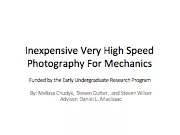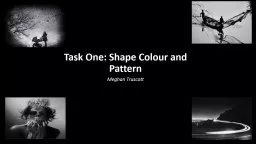PPT-Digital Photography with Flash and No-Flash Image Pairs
Author : mitsue-stanley | Published Date : 2016-04-19
By Georg Petschnigg Maneesh Agrawala Hugues Hoppe Richard Szeliski Michael Cohen Kentaro Toyama Microsoft Corporation Presented by Yael Amsterdamer Advanced Topics
Presentation Embed Code
Download Presentation
Download Presentation The PPT/PDF document "Digital Photography with Flash and No-Fl..." is the property of its rightful owner. Permission is granted to download and print the materials on this website for personal, non-commercial use only, and to display it on your personal computer provided you do not modify the materials and that you retain all copyright notices contained in the materials. By downloading content from our website, you accept the terms of this agreement.
Digital Photography with Flash and No-Flash Image Pairs: Transcript
Download Rules Of Document
"Digital Photography with Flash and No-Flash Image Pairs"The content belongs to its owner. You may download and print it for personal use, without modification, and keep all copyright notices. By downloading, you agree to these terms.
Related Documents














